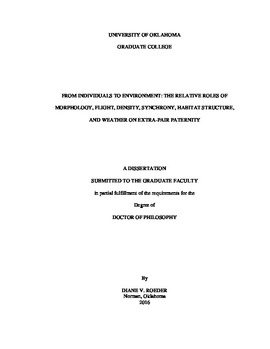| dc.description.abstract | Reproductive success is driven in large part by the mating system of a species, which ultimately determines patterns of gene transmission across generations. In species with socially monogamous mating systems, an important component of reproductive success is extra-pair paternity (EPP), when males obtain fertilizations outside of their social pairing. While social monogamy is rare in most taxa, it is the most common mating system of birds and >75% of species have appreciable rates of EPP. Although, the distribution of EPP in birds has a large phylogenetic component, there is a great deal of variability across populations, suggesting contemporary constraints on extra-pair behavior. Given the prevalence of EPP in birds, it is important that we understand how these factors interact to drive or constrain the opportunity for EPP, and thus sexual selection and the genetic contribution of individuals to the next generation. In this dissertation, I examined the distribution of EPP between the two main passerine suborders, and then attempted to elucidate the influence of individual, ecological, and environment characteristics individually, and finally, in combination, on the probability of EPP in nests of a savannah oscine passerine, the Scissor-tailed Flycatcher (Tyrannus forficatus). In Chapter 1, I compared EPP rates in commonly studied oscine species (Suborder Passeri) to those in the less frequently studied suboscines (Suborder Tyranni). I found similar EPP rates between the suborders and suggest that generalizations from oscines may be extended to this group. In addition, I used molecular techniques to investigate EPP rates in the suboscine Scissor-tailed Flycatcher and found that the population under study had high rates of EPP compared to other passerine species, with 73% of nests containing extra-pair young and 59% of young resulting from extra-pair copulations. In Chapter 2, I used this species to examine whether individual characteristics influence the distribution of EPP in the population. Males in good body condition and with a high degree of tail symmetry, which may have indicated individual quality, were cuckolded infrequently. Females may have been more faithful to high quality males or, alternately, these males may have been better able to continuously guard their mates from extra-pair copulation (EPC) attempts. In Chapter 3, I moved beyond the individual to ask how timing of nesting, breeding density, and breeding synchrony influence the frequency with which individuals interact, and thus rates of EPP. I found that EPP was negatively influenced by the distance to neighbors with synchronously fertile mates and that cuckolded males and their cuckolders were not mate-guarding concurrently. These results suggest that males with fertile mates must invest their time into mate-guarding to assure paternity in their own nests, while males not mate-guarding are free to seek EPCs. I also investigated how habitat structure on breeding territories influenced EPP. I found that EPP declined with an increase in shrub perches from which a male could survey his territory, but increased with greater tree abundance, which likely obscured a male’s view of his territory and provided cover for EPCs with intruding males. Cuckoldry was also more likely as fence length increased. Fences were used as foraging perches by birds from neighboring territories, bringing together birds that would normally not have interacted. Man-made structures that influence habitat structure may thus artificially alter reproductive behavior by changing how individuals interact. In Chapter 4, I address the influence of weather conditions, which can be quite extreme in savannah systems, on the probability of EPP. EPP was less prevalent when the social female of a pair was fertile during high vapor pressure deficit conditions. Low vapor pressure deficit indicates moist air and decreases a bird’s ability to thermoregulate through evaporative heat loss. Heat stress may make mate-guarding more difficult for males and resisting EPC attempts more difficult for females, resulting in higher EPP rates. EPP was also low when minimum daily temperature was variable, indicating the occurrence of cold mornings in the normally hot summer breeding months. To maintain their energy reserves needed for thermoregulation, all birds likely spent more time foraging and less time seeking EPCs on cold mornings. Finally, in Chapter 5, I assessed the relative importance of predictors from all datasets when examined together using path analysis. I found that morphology was not influential when put in the context of ecological or environmental conditions. Instead, variables that directly and indirectly influenced interaction rates between breeding individuals (nearest synchronous neighbor distance, breeding density, breeding synchrony, fence length) had the strongest relationship with EPP. These were followed in importance by variables that directly and indirectly modified the ability of individuals to interact (vapor pressure deficit directly, minimum daily temperature variability, maximum wind speed average and variability). These results emphasize the importance of the context in which reproductive decisions occur. Morphology may have been under sexual selection at a fine scale, but opportunities for cuckoldry likely depended on ecological and environmental conditions. Interaction rates between social mates and with potential extra-pair partners depended on the distribution and synchrony of breeding individuals, while ambient weather conditions modified the ability of individuals to interact during fertility by constraining the ability of individuals to mate-guard and pursue EPCs. | en_US |
